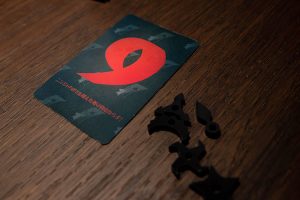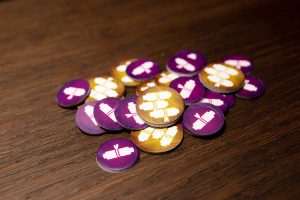 When I say I love trick-taking games, I mean it. One of my best gaming events in recent memory was a trick-taking focused mini-convention that I drove 2.5 hours to, even though I could only stay for one night. In that 30 or so hours, I managed to play about 20 trick-taking games.
When I say I love trick-taking games, I mean it. One of my best gaming events in recent memory was a trick-taking focused mini-convention that I drove 2.5 hours to, even though I could only stay for one night. In that 30 or so hours, I managed to play about 20 trick-taking games.
They offer such a breadth of different experiences despite relying heavily on similar mechanisms. And once you know the basics you can pretty quickly start playing a new-to-you trick-taking game just by getting the quick rundown of what makes that particular game unique.
So today let’s look into what makes Oboro Ninja Star Trick different from the huge variety of what you may already be familiar with and find out if you should add it to your collection.
Gameplay Overview:
The deck for Oboro Ninja Star Trick is fairly straightforward—three colored suits with ranks from 1-8. The rules for playing a trick are similarly pretty standard. The first player can play any card from their hand. Every other player must play from the same suit if they can. If they can’t, they are free to play any card. The highest-rank card wins the trick with ties going to whoever played that highest-ranked value last.
Where Oboro sets itself apart is what happens when you win a trick. You take all of the cards played to the trick and place them in front of you. You’ll have one pile for each of the three colors (green, blue, red). You’ll sort the cards from the trick you win from lowest to highest and place them, by color, on top of the cards you already have showing.

As an example – let’s say you win a trick where the three cards are all red and the ranks are 1, 5, and 7. You’ll put the 1 on top and the 5 and 7 below it in front of you. You currently have 1 point. Now, you win another trick, this time the played cards are red 6, green 2, blue 3. The red 6 will go on top of your previous won red cards, so it covers the red 1. The green 2 and blue 3 will also be on top of their new respective stacks. So now you have 11 points!
Is that good? Well, not really. You want points, obviously, but only to a certain extent. In the suggested normal rules, that limit is 9. If you go over that limit you weren’t a very good secret ninja and make too much noise or something.
The round ends after 7 tricks (8 cards are dealt, so all players have 1 card remaining). Anyone whose score is over the secrecy limit scores nothing and then whoever has the most points without going over gets 3 points, 2 points for second, and 1 for third.
There is one other thing happening in Oboro. If you win a trick that includes a 6-rank card, you’ll earn a shuriken piece as well. Once the supply of 5 shuriken pieces are exhausted, an intermediate scoring happens based on who has the most. Then all shuriken are returned to the supply. Once they are exhausted and scored a second time, the game ends at the end of that round.

Game Experience:
Trick taking games today aren’t just the Hearts, Spades, and Euchre of your parent’s generation. Recent trick-taking favorites have introduced time travel, unbalanced suits, cooperative play, and even dice. Oboro Ninja Star Trick is much closer to a traditional trick-taking but still offers its own twist.
The idea of scoring points without going over sounds a bit like push your luck, but in practice, it is much harder to describe. The idea of playing a high-value card to win a trick, while in trick-taking games is usually the “thing to do”, here you’ll often be trying to win tricks that contain fairly low cards. Or at least not huge ones. And somehow getting other players to win tricks when you play your biggest cards.
Of course, timing is everything. Winning the high-value cards early in the round gives you plenty of time to cover those points up later—so long as you can win more tricks. Leading your 8-rank card is often a terrible plan as people can throw in other high values and really inflate your points. But if you hold them too long you may just win with it when no other player has that color left, so it hurts even more.

Or you can just try to win tricks when 6s are involved as often as possible, hoping to score shuriken points and worry less about the value in your tableau. While I wouldn’t quite describe it as an alternate path to victory, it is a way to salvage points when a hand isn’t otherwise going your way.
Using the shurikens as a timer is also a really interesting mechanism. There are 5 shurikens and, obviously, three 6-rank cards. So most of the time you’ll score them at some point in the second hand. And the game will end after the fourth hand. It’s possible since all cards aren’t always played, to hold back on playing your 6s to delay scoring or to make the game go into a 5th round. While it is uncommon, it’s a fun bit of uncertainty about how long exactly you have before final scoring.
Of course, not everything is perfect with Oboro Ninja Star Trick—let’s start with the player count. You need 3 players. Not like… recommended for 3 players. It only works at three. Not two. Not four. I suppose there are a great deal of 4-player only trick-taking games that have stood the test of time, so it’s not necessarily a death knell. But it feels restrictive and like it could have been fixed by adjusting the deck and number of shurikens pretty easily.
There’s also the fact that there isn’t much flashy going on here. Oboro is a fairly standard game and the description doesn’t do a good job at selling what makes it interesting. And honestly, everyone who I played it with kind of thought it sounded boring from the teaching. Most everyone was also pleasantly surprised at how much they enjoyed it. But it isn’t the kind of game that will really entice your friends to play it over and over.
Final Thoughts:
As a connoisseur of obscure trick-taking games, I’m glad to have played Oboro Ninja Star Trick. There are plenty of trick-taking games that want you to win tricks and some that you want to avoid winning tricks. Oboro gives you the best of both worlds—win the right trick at the right time.
If you are a fan of trick-taking and often find yourself playing games with 3 players, this is worthy of picking up. I wish there were adjustments to make it work at other players counts, but when you have the right number and can convince them to give this pretty boring looking game a try, you’ll all enjoy yourselves.
Final Score: 3.5 Stars – A timing focused trick-taking game and looks pretty standard but packs plenty of interesting decisions.
 Hits:
Hits:
• “Closest without going over” scoring makes for lots of card counting fun.
• Shuriken scoring adds a neat player-controlled timing element.
Misses:
• Restrictive player count—only works with 3
• A bit of a plain-looking production and it’s hard to get excited about getting to the table.






















